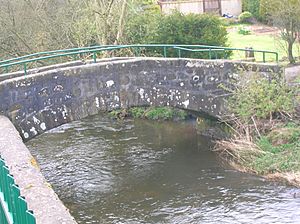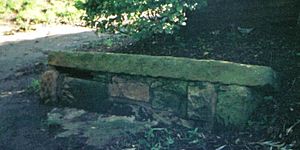Maak's or Monk's Well facts for kids
The Maak's or Monk's Well is a special old well located next to the Carmel Water in Kilmaurs, East Ayrshire, Scotland. People sometimes call it the Monk's Well. It might have been a 'Holy Well' a long time ago. This well was once a very important source of water for the people living in the village and even for those at the old Kilmaurs Place castle.
Contents
What is the Maak's Well?
The Maak's Well, also known as the Mack's or Monk's Well, used to flow into the Carmel Water. This was below Kilmaurs Place in Morton Park, Kilmaurs. It probably provided water for the people living at Kilmaurs Place a long time ago.
This well was mentioned as a water source for the village in 1709 and again in 1831. The local council even used money to keep it working as a public water supply.
The Maak's Well was famous because it never dried up. This was true even during the hottest summers. People used a lot of water from it, but it always kept flowing. However, in 2013, the well stopped flowing into the Carmel Water. This might have happened after new railings were put in along the path and river bank.
What Does the Maak's Well Look Like?
Today, the well's source is covered by a large stone slab. It is built into the hedge that borders the Kilmaurs Glencairn Bowling Club. An underground pipe carries water from the well. This pipe goes to the wall of the Carmel Water. From there, any extra water used to pour into the Carmel Water.
Old maps from the OS show how important the Maak's Well was. They show that special paths led directly to it from the north and west. This means it was easy for people to reach the well.
The History of the Maak's Well
There's an old story about the Maak's Well. It says that many years ago, the local laird (a Scottish lord) tried to stop people from using the well. When he did this, the well dried up! It only started flowing again after he changed his mind. The laird had asked a local priest for advice. The priest told him, "Give the well back to the people, let them come with their pitchers, and the waters will flow as before." After that, the well flowed without stopping until recent times.

In the past, people crossed the river using stepping stones to reach the well. A footbridge was built in 1824 to make access easier. However, stepping stones remained on the western side for some time after. The local people often say 'Mank's Well' when they talk about it.
Is the Maak's Well a Healing Well?
Some people might have thought the well had special healing powers. In April 1709, records show that water from the well was given to a sick woman. We don't know if it helped her, though. In 1831, it was called the 'Macks Well'. The name 'Monks' Well' is a changed version of this name, even though locals say 'Manks Well'.
Protecting Access to the Well
As mentioned, a nice stone pedestrian bridge replaced the old stepping stones in 1824. But in 1825, the owners of the land leading to the well tried to block people's access. This path had once been part of common land, meaning everyone could use it. Luckily, the problem was solved without needing a big legal fight.
Events at the Well
In the summer of 1826, the Carmel Water almost completely dried up. But the Maak's Well kept flowing! Local farmers brought their carts down the dry riverbed to collect water in barrels. During this time, a horse bolted (ran off suddenly). The driver, a lady, hit her head against the bridge and sadly died. Later, in 1843, two women were crossing the bridge carrying a heavy load. They fell into the Carmel Water, and one of them drowned.
In 1849, the town's officials, called burgh bailies, asked the Earl of Eglinton for help. They wanted him to repair the road and river bank leading to the Maak's Well. They also said that local stories suggested the path was originally built by a 'religious establishment', like monks.
In 1879, a person named David Landsborough wrote about the local wells and springs, including the Maak's Well. In the 1890s, John Smith mentioned the Monk's Well. However, he might have been talking about the Lady's Well near the church, not the Maak's Well.
In 1912, Duncan McNaught reported that the Maak's Well had recently been 'closed up'. This happened because a new 'gravitation water supply' was introduced. This new system brought water to the village, so the well was no longer needed as much.



